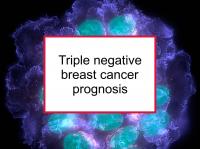Women with triple negative breast cancer are no more likely to have relapsed or died during the first five years after diagnosis than patients with other breast cancer subtypes, according to one study. However, when relapse occurs, it tends to be earlier and subsequent death sooner. See triple negative prognosis for specific outcome statistics.
Triple negative breast cancer recurrence
Triple negative breast cancer patients treated with lumpectomy and appropriate additional treatment (typically, radiotherapy and chemotherapy) have a higher risk of locoregional recurrence than other breast cancer subtypes.
Locoregional recurrence is recurrence in the breast, chest wall, or lymph nodes. However, lumpectomy is not associated with increased locoregional recurrence rates among triple negative patients compared to mastectomy.
Receiving timely treatment is especially important for triple negative breast cancer patients. One 2015 study reported that a delay of more than 90 days in starting adjuvant chemotherapy (after surgery to remove the tumor) was associated with a 53% higher risk of breast cancer-specific death compared to treatment that was started within 30 days. The comparable risk for all breast cancer types was 27%.
Rates of new tumors in the other breast and distant recurrence during the first five years after diagnosis are also higher in triple negative compared to other breast cancer subtypes regardless of type of breast surgery.
Small tumor size does not mean small risk
While small tumor size and negative lymph node status typically are associated wth favorable breast cancer prognosis, this is not necessarily the case for triple negative tumors. Women with small (< 1 cm), lymph node negative breast tumors are at higher risk of relapse if they have triple negative disease.
High rate of interval tumors means vigilance is important
There is some evidence that recurrences in the same breast or new tumors in the other breast often are self-detected rather than found as part of regular follow-up screening of breast cancer survivors. One study found that over one-third of such recurrences were not screen-detected (in other words, they were for the most part symptomatic and detected by the women themselves). The authors concluded that a recent negative mammogram should not falsely reassure women with new breast symptoms or changes because so many second cancers are interval cancers (cancers found between screening visits). Triple negative breast cancer survivors should be especially vigilant during the first five years after diagnosis and bring any changes in their breasts to the attention of their oncologists or surgeons.
Below under Selected breast cancer studies are links to recent studies concerning the prognosis of triple negative breast cancer compared to other subtypes. The studies provide specific statistics concerning survival, which varies depending on numerous factors.
Additional triple negative breast cancer articles
Below are links to some other articles concerning triple negative breast cancer.
